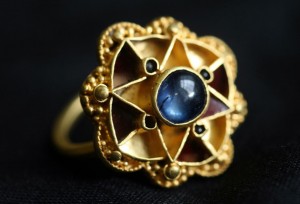 Last July the Yorkshire Museum raised £35,000 to purchase a unique Anglo-Saxon gold and sapphire finger ring. It had been found in April 2009 by a metal detectorist Michael Greenhorn, a railway technician who is also member of the York and District Metal Detecting Club. The find was reported to the Portable Antiquities Scheme and declared treasure.
Last July the Yorkshire Museum raised £35,000 to purchase a unique Anglo-Saxon gold and sapphire finger ring. It had been found in April 2009 by a metal detectorist Michael Greenhorn, a railway technician who is also member of the York and District Metal Detecting Club. The find was reported to the Portable Antiquities Scheme and declared treasure.
Sapphires were associated with high status like royalty, upper nobility or bishops. The find is so rare that there is literally nothing to compare it with, so that dating of the ring represents some difficulty. The gold beading is characteristic for the Viking period but red and blue glass set in gold is found in earlier Anglian jewelry. [continue reading…]
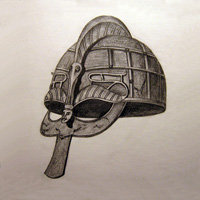
This blog is on Vikings and for Vikings. Warriors and traders from Nordic countries reached as far as North America, leaving lasting marks of their presence everywhere. In battle, Vikings feared nothing, eager to join Odin in his hall. They knew that valkyries chose who would die and become one of the einherjar in Valhalla.
 1. In Iceland, prohibition of alcoholic beverages came into effect in 1915.
1. In Iceland, prohibition of alcoholic beverages came into effect in 1915.
2. Prohibition was partially lifted for wines in 1922, because Spain and Portugal refused to import Icelandic salted cod unless Iceland imported Iberian red wine.
3. Beer remained illegal in Iceland until 1989.
4. In 1956 boxing was banned here. In 2002 amateur boxing was allowed under strict conditions, but professional boxing is forbidden until this day.
5. Geothermal fields cover up to 20% of the country’s electricity needs.
6. Icelandic horses display two additional gaits as compared to all other breeds.
7. In Iceland, if something is sold at a sale price for six consecutive weeks, that discounted price becomes the new regular price and it cannot be advertised as the sale price any more. [continue reading…]
 After emerging from bankruptcy last year, MGM is going to produce a new TV series on Vikings. The project’s executive producers are Michael Hirst and Morgan O’Sullivan. This team has already proved to be successful in both Camelot and The Tudors. Producers/managers Sherry Marsh and Alan Gasmer also take part in the project. MGM Vikings saga is reported to be a 10-episode series (or is it only the first season?). Lately premium cable channels have had a lot of success with period dramas like Rome or Spartacus. To be sure, MGM Vikings series will attract attention.
After emerging from bankruptcy last year, MGM is going to produce a new TV series on Vikings. The project’s executive producers are Michael Hirst and Morgan O’Sullivan. This team has already proved to be successful in both Camelot and The Tudors. Producers/managers Sherry Marsh and Alan Gasmer also take part in the project. MGM Vikings saga is reported to be a 10-episode series (or is it only the first season?). Lately premium cable channels have had a lot of success with period dramas like Rome or Spartacus. To be sure, MGM Vikings series will attract attention.
Hirst, who wrote all the episodes for The Tudors, will write the most of the Vikings series, too (Vikings is the working title). Hirst is said to have authored an unproduced script about Norse warriors years ago. Let us hope that as a historian he will be able to produce a great period drama about the Viking Age. [continue reading…]
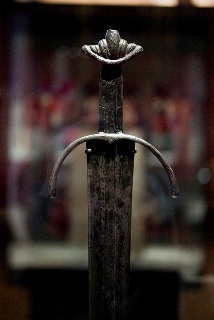 The Cawood sword is probably the finest Viking sword ever found. It was discovered in the River Ouse near York in the 19th century. The pommel type is characteristic for the Viking Age swords, while the shape of the guard is more like the ones found in 12th century weapons. This fact inclined many to believe that either the guard or the whole sword is later than the Viking Age (spanning late 8th to 11th centuries). The riddle might remain unsolved, but an almost identical sword was found in Norway. This weapon, known as the Korsoygaden sword, features a runic inscription on one of the bronze fillets that once bound the now missing grip. Both the type of the runes and the circular shield with which it was discovered allow to date it to 1100. The Cawood sword, which seems to be made by the same craftsman, should be placed around the same date. [continue reading…]
The Cawood sword is probably the finest Viking sword ever found. It was discovered in the River Ouse near York in the 19th century. The pommel type is characteristic for the Viking Age swords, while the shape of the guard is more like the ones found in 12th century weapons. This fact inclined many to believe that either the guard or the whole sword is later than the Viking Age (spanning late 8th to 11th centuries). The riddle might remain unsolved, but an almost identical sword was found in Norway. This weapon, known as the Korsoygaden sword, features a runic inscription on one of the bronze fillets that once bound the now missing grip. Both the type of the runes and the circular shield with which it was discovered allow to date it to 1100. The Cawood sword, which seems to be made by the same craftsman, should be placed around the same date. [continue reading…]
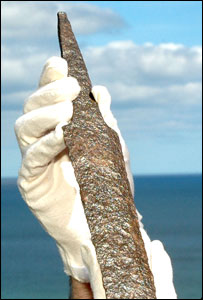 Bamburgh sword is a rare Anglo-Saxon sword from the seventh century. It once belonged to an Anglo-Saxon king or a member of a royal family. The sword was made up of six individual strands of iron: this technique is known as pattern welding, Babmburgh sword thus being a six pattern-welded sword. Cold weapons of such structure are also called ‘snake patterned’ because of the herring bone appearance created by the forged strands. Six strands or layers of carbon steel forged together made it a perfect weapon: in comparison, Sutton Hoo sword had only four layers. Bamburgh sword is the only one of its kind ever found.
Bamburgh sword is a rare Anglo-Saxon sword from the seventh century. It once belonged to an Anglo-Saxon king or a member of a royal family. The sword was made up of six individual strands of iron: this technique is known as pattern welding, Babmburgh sword thus being a six pattern-welded sword. Cold weapons of such structure are also called ‘snake patterned’ because of the herring bone appearance created by the forged strands. Six strands or layers of carbon steel forged together made it a perfect weapon: in comparison, Sutton Hoo sword had only four layers. Bamburgh sword is the only one of its kind ever found.
The recovery of the sword is rather peculiar. It was dug out during the first excavation at Bamburgh castle, Northumberland, in 1960. After that it was forgotten in the attic of the broadcaster and archeologist Brian Hope-Taylor who took part in the excavations. [continue reading…]
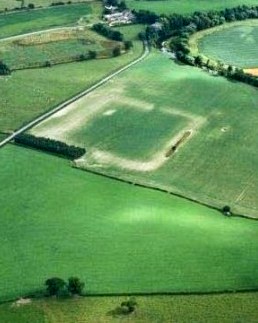
The archeological site at the Gaer Farm (close to Offa’s Dyke at Forden, near Welshpool) was identified back in 1985. Preliminary excavations and aerial photographs revealed a post-Roman settlement, but a proper investigation did not take place until August 2010, when a team from Cambrian Archaeological Projects started an excavation on what seems to be a fifth-century Saxon palace. Both the strategic border location and the magnitude of the building, which is 40m long and 15m wide, point to the fact that this had been a royal residence.Project leader Mark Houliston said it was difficult to date the site, but there are reasons to believe that it is from the Anglo-Saxon period. CAP director Kevin Blockley said that this Saxon timber long house could be a palace of the prince of Wales, a local king or a bishop. [continue reading…]
